Break me off a piece of that creative gold



Prince, Madonna and Run-D.M.C. ruled the airwaves. The Space Shuttle Challenger exploded and so did a reactor at the Chernobyl Nuclear Power Plant. It would be another three years until the Berlin Wall came down, the U.S.S.R. was still a thing and Ronald Reagan was selling weapons to Iran. In short, it was not the ideal advertising climate for a candy bar jingle.
Yet the marketing minds over at Doyle Dane Bernbach (DDB) were convinced that it was the right strategy for the Kit Kat bar, a crispy, chocolatey wafer confection manufactured by their client The Hershey Company. In fact, they had already invested a significant amount of money recording demos with leading artists.
But as anyone in advertising knows, clients like options. So DDB enlisted a junior copywriter, Ken Shuldman, and a freelance composer, Michael A. Levine, to put together an option that Hershey’s could reject (and therefore, wholeheartedly embrace the expensive, agency-endorsed jingle). Shuldman wrote down a few lyrics for Levine, who reportedly worked out the tune on a short elevator ride, and they put it in front of the client.
That’s where things started to get interesting. Because the client loved it. The agency agreed to put both jingles through testing. The “throwaway” won. Unconvinced, DDB put them through testing again. Only this time, it performed even better. And in 1986, the campaign went to market. Maybe you’ve heard of it? Gimme a break, gimme a break, break me off a piece of that Kit Kat bar.

Emotions play a leading role in decision making. Did you notice that the Kit Kat jingle doesn’t list off a collection of factual attributes? Nowhere does it say Kit Kat could be considered the healthiest candy bar in the market (being mostly made up of wafer,
air and 100% sustainable cocoa) even though it’s a key differentiator.
While insights like these are critical to informing the creative process, they aren’t always best served in the ad itself. The true success of Kit Kat’s jingle comes from its creators thinking as consumers. Pressed for time, they trusted their first instinct, leading with emotion and thinking fast, not slow (or as we learned earlier, “System 1.”) in 1986, “Gimme A Break” was what Americans needed, not despite the tumult of current events but because of them. The underdog duo’s creative idea connected with consumers’ emotions. And that emotional connection paid off, skyrocketing revenue, and building decades of brand equity. Hershey’s even had to build a whole new Kit Kat factory because of the campaign’s success.
The ability to generate creative work that sparks an emotional response from consumers is a magical process that stems from talent, experience, and intuition. But luckily for us marketing folk who don’t have the design gift, Leap Group’s creative team is sharing a few tricks they use to make creative gold.


In a brand connection study printed in Harvard Business Review, the research firm Motista found there are over 300 emotional motivators that drive consumer behavior. Often these emotional motivators are unspoken, personal, and sensitive needs, ranging from the desire to feel a sense of belonging, to succeed in life, or to feel secure.
Emotional motivators, when chosen strategically and empathetically, can be leveraged to create deep connections with consumers. To build trust and foster authentic human connection you must meet a consumer’s emotional needs, not exploit them. That’s why it’s vital for brands to choose an emotional motivator to inform their creative that aligns with existing brand values or product offering.


Do you find the Kit Kat jingle still playing in your head? That’s because the idea behind its lyrics is “stickier” than the candy itself.
Inspired by Chip and Dan Heath’s book Made to Stick: Why Some Ideas Survive and Others Die, LEAP uses the six “sticky” principles to gut check and find the ones that are the most understandable, memorable, and effective in changing thought or behavior.
At Leap Group, our creative team often reminds us, “great ideas are simple enough to fit on a post-it note but never shut the f!@k up.” These ideas usually line up with four or more of Chip and Dan’s six principles of stickiness: simplicity, unexpectedness, concreteness, credibility, emotions, and stories.




The new Kit Kat jingle didn’t have to veer too far from the successful tagline that predated it for 28 years, “Have a break, Have a Kit Kat” to breathe new life into the brand. And you don’t have to come up with a completely-from-scratch idea to create outstanding work either.
In a research study, The Fundamental Templates of Quality Ads, Goldenburg, Mazursky and Solomon found that there are six archetypes (or templates) represented in more than 89% of award-winning and effective advertisements.

They are: Extreme Consequences, Pictorial Analogy, Extreme Situations, Competition, Interactive Experiments, Dimensional Alteration.
Gimmie a Break
Time to think as your consumer. What’s your emotional motivator? Root yourself in empathy as you think about how you can use this motivator in your creative output.
These are the top 10 most common or high-impact emotional motivators:
1. Stand out from the crowd
Project a unique social identity; be seen as special
2. Have confidence in the future
Perceive the future as better than the past; have
a positive mental picture of what’s to come
3. Enjoy a sense of well-being
Feel that life measures up to expectations and that balance has been achieved; seek a stress-free state without conflicts or threats
4. Feel a sense of freedom
Act independently, without obligations
or restrictions
5. Feel a sense of thrill
Experience visceral, overwhelming pleasure and excitement; participate in exciting, fun events
6. Feel a sense of belonging
Have an affiliation with people they relate to
or aspire to be like; feel part of a group
7. Protect the environment
Sustain the belief that the environment is sacred; take action to improve their surroundings
8. Be the person I want to be
Fulfill a desire for ongoing self-improvement; live
up to their ideal self-image
9. Feel secure
Believe that what they have today will be there tomorrow; pursue goals and dreams without worry
10. Succeed in life
Feel that they lead meaningful lives; find worth that goes beyond financial or socioeconomic measures
Gimmie a Break
Take a break from reading to think about an upcoming marketing campaign, product, or new program you’re planning to launch. Do your messaging or product
attributes hold up across the six sticky principles?
Take a break from reading to think about an upcoming marketing campaign, product, or new program you’re planning to launch. Do your messaging or product
attributes hold up across the six sticky principles?
- Simple: What’s the essential core of the idea?
- Unexpected: Does it grab people’s attention?
- Concrete: Is the idea clear? Abstract?
- Credible: Will people believe it?
- Emotion: Will they care?
- Story: Does it inspire people? Spur action?
Is your idea bolstered in the context of an advertising archetype?
Taking your brand or product and giving it new life in the context of one of these six archetypes can help you not only avoid writers block but also be perceived as across as original, the researchers found.
Extreme Consequences

Points out unexpected consequences of a
product attribute.
Pictorial Analogy

Extreme analogies are rendered visually, typically replacing a symbol of the product with the symbol of the value it wants to represent
Extreme Situations

Product is seen performing under extreme or unusual circumstances
Competition

A product or brand is seen winning in competition with another product or brand, often in an unusual situation.
Interactive Experiments

Viewers interact with the
product directly.
Dimensional Alteration

A peek into the future, showing the long-term implications of the product.

“Gimme A Break” comes with an undeniably catchy tune, but let’s be honest: it wouldn’t have any chance of being stuck in your head right now if you’d never heard it. That is, if Hershey’s hadn’t made a proper investment in media, airing it with effective
frequency on the right radio and television channels for its audience. That’s why you can’t overlook the importance of a good creative brief. It helps you think about how your audience will interact with your ad once it’s served or seen. Context (like the time, location, or logic around when the ad is served) can present additional opportunities to personalize your message and increase conversions. And the medium of the final product – whether digital, print, or OOH – can serve as guardrails to help you focus your energy on delivering that right message at the right time.


In Ryan Holiday’s book, Stillness is The Key, he shares that stillness inspires new ideas, sharpens perspective, illuminates connections, generates vision, makes space for gratitude and wonder. Taking time to be still and let your mind wander “is the key that unlocks the insights of genius and allows us regular folks to understand them.”



Maybe you start with the left wafer or right wafer…or maybe you bite into both at the same time like LEAP’s Corporate Creative Director. The point is, you have a preference. The same applies to your creative process. Your own personal process may be working, like it did for Shuldman and Levine. Or you may find yourself in a position like the team at DDB, and need to pivot. Whatever your process, if you think like your consumer and lean into emotion (using left-brain and right-brain thinking) you’re guaranteed to get sweet results.